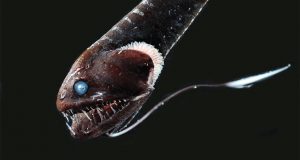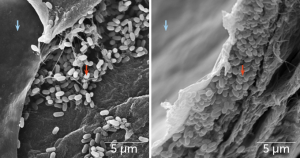The ongoing battle between predator and prey has led to unique adaptations, one of these is camouflage. Camouflage is static used by organisms to disguise their appearance. This can clearly be seen in the cuttlefish who can change the color of its skin to match the color of its background or arctic foxes whose fur is white during the winter and brown throughout the summer. Recently a group of researchers have been looking at camouflage in deep sea organisms. Previously deep sea organisms were observed having translucent or reflective bodies. This can provide camouflage due to the extreme low light level at these depths. In the deep ocean a translucent organism can reflect as little as 0.4% of light making them almost indistinguishable from the dark surroundings. Alternatively reflective fish has so little light to reflect at these depths that it too appears to blend the background color. However these were not the adaptation that these researchers were interested in, instead they examined what they call “super black” organisms. A “super black” organism is one which reflects less than 0.5% of the light they interact with. This led the researchers to question why these organisms have this adaptation and how these organisms reflect so little light.
The simple answer to why these organisms reflect so little light is that we don’t really know. The researchers studied 16 different fish species across seven different orders of fish. This means that each organism probably has a unique reason for this adaptation. One reason the researchers think this adaptation could be helpful, is due to the high use of bioluminescence in this environment. Due to the low light levels in these environments organisms use bioluminescence in multiple ways, such as finding a mate or food. However for a reflective fish, nearby bioluminescence can easily expose their location. Furthermore even a translucent organism who has very little interaction with light, can still be detected by some deep sea organisms in the presence of bioluminescence. From this the researchers think that the “super black” adaptation may help deep sea organisms remain undetected in the presence of bioluminescence. One of the fish that pointed the researchers in this direction was a bait fish, this is a fish like the anglerfish which uses bioluminescence to attract prey. The researchers hypothesize that a fish like this could use its “super black” adaptation in order for its body to not be detected by its prey while it’s using bioluminescence, however more research needs to be done to answer why these organisms have this “super black” adaptation.

Idiacanthus antrostomus a baitfish with “super black” skin by K. Osborn/Smithsonian National Museum of Natural History
These organisms achieve “super black” through a pigment on their skin called melanin. The melanin is organized in an organelle called the melanosomes which can absorb up to 99.95% of light. The fish considered “super black” had skin which contained layers of these melanosomes as shown below. This allows light which is reflected from one melanosome to be absorbed by a different melanosome. This system for achieving such a high level of light absorption is relatively simpler than those found in birds or butterflies who are also considered “super black.” Due to this the researchers are hopeful that it could be an easier way of producing a system with a high level of light absorption for use in solar power generators, radiometers, industrial baffles and telescopes.

Electron microscope image of melanosomes in deep sea fish, the melanosomes are indicated by the red arrow, while a skin membrane is indicated by the blue arrow. Image taken by K. Osborn/Smithsonian National Museum of Natural History and A.L. Davis et. al./Current Biology 2020
